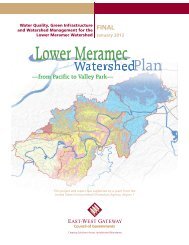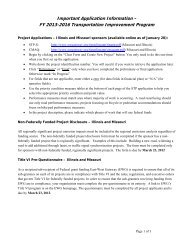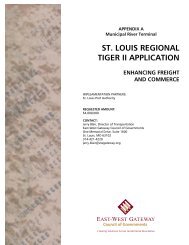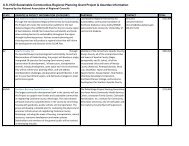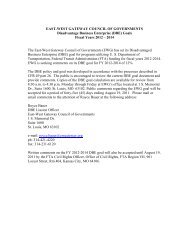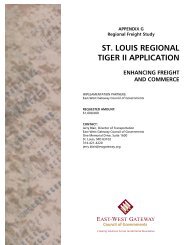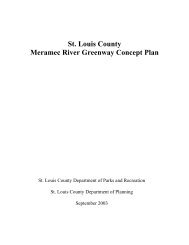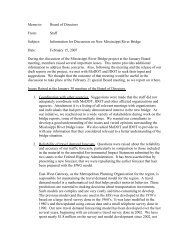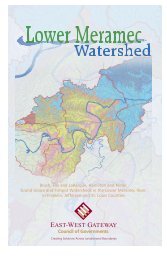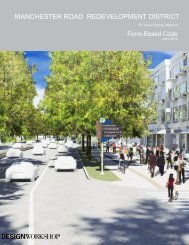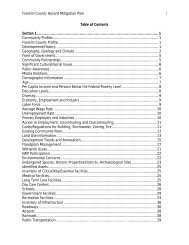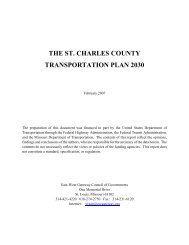Jefferson County - East-West Gateway Coordinating Council
Jefferson County - East-West Gateway Coordinating Council
Jefferson County - East-West Gateway Coordinating Council
Create successful ePaper yourself
Turn your PDF publications into a flip-book with our unique Google optimized e-Paper software.
36<br />
Inventory of Infrastructures<br />
<strong>Jefferson</strong> <strong>County</strong> – Section 1<br />
<strong>County</strong> infrastructures include transportation, communications, water/sewer,<br />
electricity and natural gas, solid waste disposal, law enforcement, fire protection,<br />
emergency medical services and emergency management.<br />
Transportation<br />
The road network has a great impact on <strong>Jefferson</strong> <strong>County</strong>. On the eastern side of the<br />
county lies the primary north/south transportation route, Interstate I-55. I-55 connects the<br />
St. Louis region to points north and south. Interstate I-44 lies in the northwest corner of<br />
the county connecting the region to areas southwest and northeast. Internally, a web of<br />
state and county roads connects <strong>Jefferson</strong> <strong>County</strong>. State Highway 61/67 and 21 are the<br />
primary north/south connectors. Highway 30 runs northeast/southwest through the<br />
northwest quadrant of the county. Highways M and MM provide a major eat/west<br />
connection from I-55 and highway 30, in the northern part of the county. The county<br />
lacks major east/west connections south of the M-MM corridor. Narrow county roads<br />
provide indirect access in much of the southern portion of the county. Local roads that<br />
serve subdivisions and neighborhoods are classified as privately owned and dedicated to<br />
public use. Thus, for these subdivisions, the homeowner’s association is responsible for<br />
maintenance. See Figure J10 located in the back of the Technical Appendix.<br />
The <strong>County</strong> Commission convened the Transportation Advisory Committee on September<br />
16, 1999. The overall purpose of the TAC is to serve as the source of long-range planning<br />
and strategies and shared local transportation policy making for <strong>Jefferson</strong> <strong>County</strong>. They will<br />
advise the <strong>County</strong> Commission on funding, administration, and operation of publicly<br />
supported agencies involved in the delivery of services for all modes of transportation, and<br />
they will act as a focal point for cooperation and coordination between all stakeholders in<br />
the delivery of transportation services.<br />
One of the immediate tasks of the Transportation Advisory Committee (TAC) was to<br />
investigate the transportation needs of the elderly, handicapped, Welfare-to-work<br />
population and others with special medical and job service needs. The TAC found that the<br />
transportation needs of these segments of the <strong>Jefferson</strong> <strong>County</strong> population are not being<br />
sufficiently met. The key issues surrounding this finding are: 1) insufficient funding for<br />
current providers; 2) communication between service providers is limited; 3) there is no<br />
mass transit available in the <strong>County</strong>; 4) data on needed services is not available; 5) there is<br />
no standard on data collection; and 6) the <strong>County</strong> is not accessing all the money available<br />
to resource transportation services. All of these issues impact the physically disabled, the<br />
elderly, and others with medical and job service needs.<br />
The TAC has the following short term recommendations to address these issues: 1)<br />
contract a public transit needs study; 2) create a centralized automated information center;<br />
3) expand dialog with mass transit providers; 4) research the availability for potential



